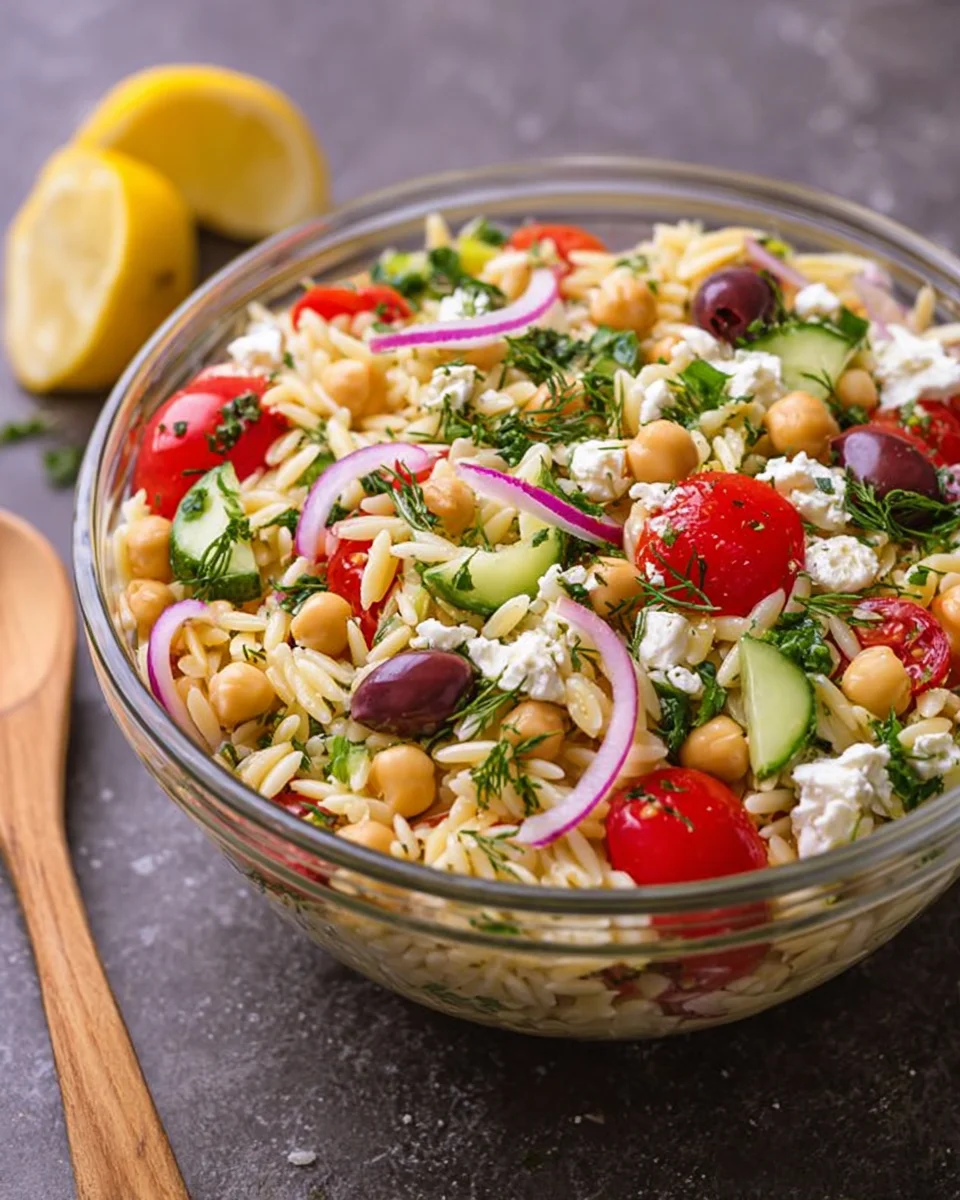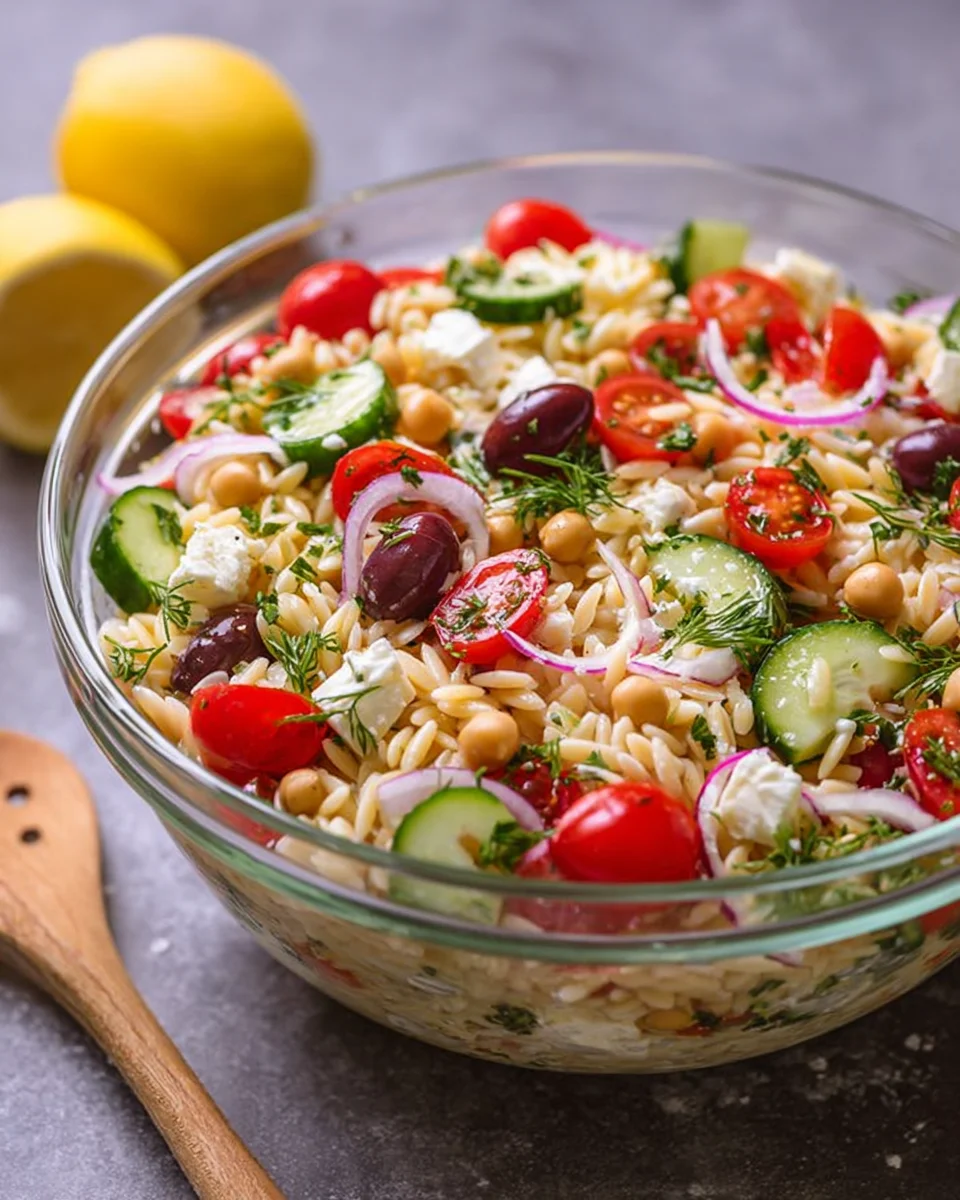
This Greek Orzo Salad is a delightful mix of fresh ingredients, perfect for any occasion. Whether you’re hosting a summer barbecue, enjoying a picnic, or simply looking for a quick meal, this salad is sure to impress. The combination of feta cheese, chickpeas, and vibrant vegetables creates a burst of flavor that makes healthy eating enjoyable.
Why You’ll Love This Greek Orzo Salad
This Greek Orzo Salad stands out with its unique features that cater to various tastes and preferences.
- Easy to Prepare: With simple steps and minimal cooking time, this dish comes together quickly.
- Bursting with Flavor: The mix of fresh veggies, tangy feta, and zesty dressing ensures every bite is delicious.
- Versatile Dish: Perfect as a side or main dish; it can be served warm or cold.
- Healthy Ingredients: Packed with protein from chickpeas and loaded with fresh vegetables, it’s nutritious too!
- Customizable: Feel free to add your favorite proteins like chicken or shrimp for extra heartiness.
Tools and Preparation
Preparing this Greek Orzo Salad requires just a few essential tools to ensure everything goes smoothly.
Essential Tools and Equipment
- Large pot
- Colander
- Cutting board
- Knife
- Mixing bowl
Importance of Each Tool
- Large pot: Necessary for cooking the orzo evenly in boiling water.
- Colander: Essential for draining and rinsing the cooked pasta effectively.
- Cutting board: Provides a stable surface for chopping vegetables safely.
- Knife: A sharp knife makes cutting ingredients quick and easy.
Ingredients
- 1 pound orzo
- 1 large english cucumber (sliced in half lengthwise then cut into half moons)
- 2 cups cherry tomatoes (cut in half)
- 1/2 cup kalamata olives (pitted and sliced in half)
- 1 small red bell pepper (seeds removed and diced)
- 1 small green pepper (seeds removed and diced)
- 1 15.5 ounce can chickpeas (drained, rinsed, and patted dry)
- 1 small red onion (diced)
- 1 8 ounce container feta cheese (crumbled)
- 1/2 cup olive oil
- 2 cloves garlic, minced
- 3 tablespoons red wine vinegar
- 1 and 1/2 Tablespoons Lemon Juice (freshly squeezed)
- 1 teaspoon lemon zest (finely grated)
- 1 and 1/2 teaspoons dijon mustard
- 1 teaspoon fresh oregano (finely chopped or 1/2 teaspoon dried)
- 1 teaspoon granulated sugar
- 1/2 teaspoon salt (more to taste)
- 1/2 teaspoon ground black pepper (more to taste)
- 2 Tablespoons kalamata olives (finely chopped)

How to Make Greek Orzo Salad
Step 1: Cook the Orzo
Place a large pot of salted water over high heat and bring it to a rolling boil. Add the orzo and cook until al dente, which takes about 7 to 8 minutes.
Step 2: Drain and Rinse the Pasta
Once the orzo is cooked, drain it using a colander. Rinse under cold water until cool to stop the cooking process.
Step 3: Combine Ingredients in Bowl
Transfer the cooled pasta into a large serving bowl.
Step 4: Prepare Vegetables and Dressing
While the pasta cooks, chop all your vegetables as listed in the ingredients section. In another bowl, whisk together olive oil, garlic, red wine vinegar, lemon juice, lemon zest, dijon mustard, oregano, sugar, salt, and black pepper to create the dressing.
Step 5: Toss Everything Together
Add the chopped vegetables, chickpeas, feta cheese, and kalamata olives into the bowl with the orzo. Pour in the dressing and toss everything together gently until well combined.
Enjoy your refreshing Greek Orzo Salad!
How to Serve Greek Orzo Salad
Greek Orzo Salad is a versatile dish that fits perfectly in various serving situations. Whether you’re hosting a summer barbecue, a casual dinner, or just looking for a quick meal, this salad can shine on any table.
As a Main Course
- Enjoy it as a light main dish, especially during warm weather. The combination of orzo, chickpeas, and fresh vegetables makes it filling.
As a Side Dish
- Pair it with grilled meats like chicken or fish. The flavors in the salad complement the charred taste of grilled foods wonderfully.
For Meal Prep
- Pack individual servings in containers for easy grab-and-go lunches. The flavors deepen as it sits, making it even tastier the next day.
At Potlucks
- Bring this colorful salad to share at gatherings. Its vibrant colors and refreshing taste will surely impress your friends and family.
With Additional Proteins
- Add grilled chicken or shrimp for extra protein. This makes it a heartier meal while still keeping it light and fresh.
How to Perfect Greek Orzo Salad
Creating the perfect Greek Orzo Salad takes just a few simple steps. Here are some tips to ensure you achieve the best flavor and texture.
- Use fresh ingredients: Fresh vegetables and herbs enhance the overall taste of your salad.
- Cool the orzo: Rinse the pasta under cold water after cooking to stop the cooking process and keep it from becoming mushy.
- Make your dressing ahead: Allowing the dressing to sit for at least 30 minutes helps develop flavors before mixing with the salad.
- Adjust seasonings: Always taste your salad before serving. You may want to add more salt, pepper, or lemon juice to suit your palate.
- Let it chill: Refrigerate your salad for at least an hour before serving. This allows all the flavors to meld together beautifully.
- Experiment with add-ins: Feel free to customize with roasted red peppers or artichoke hearts for added flavor and texture.

Best Side Dishes for Greek Orzo Salad
Pairing side dishes with Greek Orzo Salad can elevate your meal experience. Here are some delicious options that complement this vibrant salad perfectly.
- Grilled Chicken Skewers: Marinate chicken pieces in lemon and herbs before grilling for juicy bites that match well with the salad.
- Roasted Vegetables: A mix of seasonal veggies roasted until tender adds warmth and complements the freshness of the salad.
- Pita Bread with Hummus: Serve warm pita bread alongside creamy hummus for a delightful dipping option.
- Stuffed Grape Leaves: These traditional Mediterranean bites bring rich flavor and texture that pairs beautifully with orzo.
- Tzatziki Sauce with Chips: A refreshing yogurt cucumber dip served with crispy chips makes for excellent finger food.
- Caprese Skewers: Cherry tomatoes, mozzarella balls, and basil drizzled with balsamic glaze offer a fresh, tangy bite that’s easy to prepare.
- Lemon Herb Quinoa: This light side dish brings extra protein while maintaining Mediterranean vibes through lemon and herbs.
- Greek Yogurt Dip with Veggies: A creamy dip served with crunchy vegetables enhances snacking options alongside your meal.
Common Mistakes to Avoid
Avoiding common mistakes can enhance your Greek Orzo Salad experience. Here are a few pitfalls to watch out for:
- Using overcooked orzo: Cooking the orzo too long makes it mushy. Aim for al dente for the best texture.
- Skipping the rinsing step: Failing to rinse the cooked orzo can result in a sticky salad. Rinse with cold water to keep it separate and cool.
- Neglecting fresh ingredients: Using wilted vegetables can dull flavors. Always opt for fresh, vibrant produce for a delicious salad.
- Ignoring seasoning adjustments: Not tasting and adjusting seasoning can lead to blandness. Add salt and pepper gradually until you reach your desired flavor.
- Making it too early: Preparing your salad too far in advance can cause it to lose freshness. Assemble close to serving time for optimal taste.
Storage & Reheating Instructions
Refrigerator Storage
- Store in an airtight container.
- Keeps well for up to 3 days.
- Ensure it’s cooled completely before refrigerating.
Freezing Instructions
- This Greek Orzo Salad is not ideal for freezing due to the fresh vegetables.
- If necessary, freeze the dressing separately.
- Consume within a month if frozen.
Reheating Instructions
- Oven: Preheat at 350°F (175°C). Spread salad on a baking sheet and heat for about 10 minutes, stirring occasionally.
- Microwave: Place in a microwave-safe bowl, cover loosely, and heat in short bursts of 30 seconds until warmed through.
- Stovetop: Heat over medium heat in a skillet with a splash of olive oil, stirring frequently until warm.

Frequently Asked Questions
What makes Greek Orzo Salad healthy?
This salad is packed with fresh vegetables, protein from chickpeas, and healthy fats from olive oil, making it a nutritious choice.
Can I customize my Greek Orzo Salad?
Absolutely! You can add grilled chicken or shrimp for extra protein or throw in your favorite veggies like spinach or artichokes.
How do I make the dressing for Greek Orzo Salad?
Mix olive oil, red wine vinegar, lemon juice, Dijon mustard, garlic, oregano, salt, and pepper to create a zesty dressing that complements the salad perfectly.
How long does Greek Orzo Salad last?
When stored properly in the fridge, it lasts up to 3 days. For best taste, consume within this time frame.
Final Thoughts
This Greek Orzo Salad is not only vibrant but also versatile and easy to prepare. Perfect as a summer side dish or light lunch option, you can customize it with various proteins and vegetables. Give this recipe a try; you’ll love how refreshing and satisfying it is!

Greek Orzo Salad
Experience the vibrant flavors of our Greek Orzo Salad, a delightful dish that combines healthy ingredients into a refreshing medley perfect for any occasion. This salad features al dente orzo, protein-packed chickpeas, and a colorful array of fresh vegetables, all tossed in a zesty homemade dressing. Whether you’re hosting a summer barbecue, packing for a picnic, or simply looking for a nutritious meal, this salad is easy to prepare and customizable to suit your taste buds. Enjoy it as a main course or serve it as an accompaniment to grilled meats. Packed with flavor and nutrition, this Greek Orzo Salad is sure to impress your family and friends!
- Total Time: 23 minutes
- Yield: Serves approximately 6 people 1x
Ingredients
- 1 pound orzo
- 1 large English cucumber
- 2 cups cherry tomatoes
- 1/2 cup kalamata olives
- 1 small red bell pepper
- 1 small green pepper
- 1 can (15.5 oz) chickpeas
- 1 small red onion
- 8 oz feta cheese
- 1/2 cup olive oil
- 2 cloves garlic
- 3 tablespoons red wine vinegar
- 1 and 1/2 tablespoons lemon juice
- 1 teaspoon lemon zest
- 1 and 1/2 teaspoons Dijon mustard
- 1 teaspoon fresh oregano
- 1 teaspoon granulated sugar
- 1/2 teaspoon salt
- 1/2 teaspoon ground black pepper
- 2 tablespoons kalamata olives
Instructions
- Cook the orzo in salted boiling water for 7-8 minutes until al dente. Drain and rinse under cold water.
- In a large bowl, combine cooled orzo with diced vegetables, chickpeas, feta cheese, and olives.
- Whisk together olive oil, garlic, vinegar, lemon juice, mustard, oregano, sugar, salt, and pepper for the dressing.
- Pour dressing over the salad mixture and toss gently until combined.
- Prep Time: 15 minutes
- Cook Time: 8 minutes
- Category: Sides
- Method: Boiling
- Cuisine: Mediterranean
Nutrition
- Serving Size: 1 serving
- Calories: 320
- Sugar: 3g
- Sodium: 450mg
- Fat: 16g
- Saturated Fat: 4g
- Unsaturated Fat: 12g
- Trans Fat: 0g
- Carbohydrates: 35g
- Fiber: 6g
- Protein: 10g
- Cholesterol: 15mg




Leave a Comment